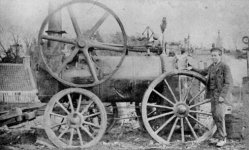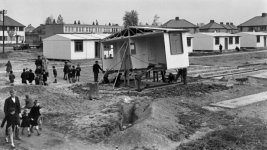Can anybody here direct me to the biographical account where the good Dr. was lying sick in bed of malaria and as a relief from the heat, the bellows vacuum system in the house in Africa was reversed and the exhaust of the steam engine was used to air condition the house to great effect. In fact, a barrel of water beneath the exhaust port had a layer of ice each morning. I remember reading about this years ago. Good luck Googling it.
p.s. here's where Galu's Google prowess could be used to good effect, after all my interest is only in saving the planet. 🙂
p.s. here's where Galu's Google prowess could be used to good effect, after all my interest is only in saving the planet. 🙂
Last edited:
There's no mention of steam engines in my Ladybird book, Pete! 😉
No results here either: https://archive.org/details/popularaccountof00livi/mode/2up?q=bellows+vacuum+system
No results here either: https://archive.org/details/popularaccountof00livi/mode/2up?q=bellows+vacuum+system
Attachments
Spencer Tracey and Cedric Hardwicke?
https://www.imdb.com/title/tt0031973/characters/nm0362567?ref_=tt_cl_c_6
https://www.imdb.com/title/tt0031973/characters/nm0362567?ref_=tt_cl_c_6
Unlikely story, where was the coal?
Wood yes, from the forests, as fuel, that is possible.
And water, they need lots of clean water.
And he lived in remote areas, steam engines are kind of difficult to haul around.
Heavy in weight compared to internal combustion engines....you would need rail tracks or a lorry.
He died in 1873.
Wood yes, from the forests, as fuel, that is possible.
And water, they need lots of clean water.
And he lived in remote areas, steam engines are kind of difficult to haul around.
Heavy in weight compared to internal combustion engines....you would need rail tracks or a lorry.
He died in 1873.
They brought it from Newcastle in 100# sacks.Unlikely story, where was the coal?
If you look it up, the old steam engines went through lots of coal, the stoker on railway engines had to be strong, they needed to send hundreds of kilos every hour...
We had steam engines here when I was a child, a meter gauge loco would need many tons of coal to go for the 7 hour journey to Delhi from Jaipur.
And water does not freeze so easily in most of Africa.
We had steam engines here when I was a child, a meter gauge loco would need many tons of coal to go for the 7 hour journey to Delhi from Jaipur.
And water does not freeze so easily in most of Africa.
This would have been a relatively small engine. The expanding exhaust of a steam engine is very cold. The water barrel was in the basement. This is a biographical account.
https://www.martynbane.co.uk/modernsteam/hvalentine/condense.htm
I am still skeptical.
Maybe an air ejector or Coanda Effect device was used.
Anyway, the engine is possibly not described, so I am being pedantic.
I am still skeptical.
Maybe an air ejector or Coanda Effect device was used.
Anyway, the engine is possibly not described, so I am being pedantic.
Only if expanded to a vacuum. This is routine in BIG steam engines, factory size and larger. That's what the cooling towers, or ponds or rivers, are for, to cool the condensate. Holding a deep vacuum (no back pressure) is key to turbine efficiency.This would have been a relatively small engine. The expanding exhaust of a steam engine is very cold.
Vacuum condensation does not make much engineering sense for smaller 'portable' engines. The condenser and its ancilaries are typically bigger than the engine and not cheap. It has been done occasionally to reduce the fog and conserve the water. Stanley Steamers in the UK were operated with condensers due to fog-law.
Without a vacuum condenser, steam into atmosphere will cool to 100/212 degrees and go to water, which cools more slowly (dense per surface area).
I do see the resemblance to compressed gas release. CO2 will expand to dry ice. But it is cooled to ambient after compression, lots of time for energy to be released before expansion.
Compressed air engines do have trouble with ice in the exhaust. (Is that maybe what you read? Compressed air was used for drilling in the diamond fields but that was distant in time and space from Livingston.) I never heard of a cold steam exhaust.
It seems we are getting confused between steam turbines and steam engines...in engines steam pushed pistons, and the exhaust gases were spent steam.
The pistons worked crankshafts among othere things...
I never heard of freezing cold exhaust from a steam engine either...
The pistons worked crankshafts among othere things...
I never heard of freezing cold exhaust from a steam engine either...
Absorption refrigerators look to have been invented in the late 1850s so unlikely that had made it to Africa. Although it did take me some time to work out how they cool buildings in Manhatten using steam....
"..the exhaust of the steam engine was used to air condition the house to great effect."
Unbelievable.
A thermal engine whatever fuel or piston or turbine cannot give a temperature below ambient.
It makes mechanical energy from a heat source and a cold sink. Here comes, CARNOT and the second thermodynamics principle.
The cold sink is the condenser cooled by the ambient some with the trick of water evaporating.
The evaporating gives some cold, the thermal engine does not.
Unbelievable.
A thermal engine whatever fuel or piston or turbine cannot give a temperature below ambient.
It makes mechanical energy from a heat source and a cold sink. Here comes, CARNOT and the second thermodynamics principle.
The cold sink is the condenser cooled by the ambient some with the trick of water evaporating.
The evaporating gives some cold, the thermal engine does not.
My aunt had a gas powered fridge, and a spirit (blowlamp) powered clothes iron, which she exchanged with me, taking an electric iron as payment.
The iron is Tilley (English), I still have it, but never tried using it, it remains a collectible item.
A hospital here uses a gas powered absorption chiller system, I think it has refrigerant gases, or at least some gas is used as heat transfer medium, IIRC.
Not invented till much later than 1860.
The outlet of the evaporator would have absorbed some heat from the exhaust, so unlikely to be at ambient when its discharge is measured.
The building HVAC systems in Manhattan also were developed much later.
So I am still skeptical.
The iron is Tilley (English), I still have it, but never tried using it, it remains a collectible item.
A hospital here uses a gas powered absorption chiller system, I think it has refrigerant gases, or at least some gas is used as heat transfer medium, IIRC.
Not invented till much later than 1860.
The outlet of the evaporator would have absorbed some heat from the exhaust, so unlikely to be at ambient when its discharge is measured.
The building HVAC systems in Manhattan also were developed much later.
So I am still skeptical.
This would have been a relatively small engine.
Even portable steam engines were substantial around the time of Livingstone's departure from this world.
Attachments
and wasn't it about 1870 before boiler inspections became a legal requirement as too many people were dying in boiler explosions?
Yes (from several posts back 😕 ) . . It does seem like the relevant bulk-physics may have escaped the understanding of the author you mentioned.
One thing I'm pretty sure of -- in tropical climates, producing significant cold (many dozens of BTU's removed) would not likely be a serendipitous discovery.
Also, an apology and a Thank You to NareshBrd -- on another thread you 'learned me up' on a Yiddish word that I had no idea the origin of. Next time I'll know better! Thanks.
Cheers
One thing I'm pretty sure of -- in tropical climates, producing significant cold (many dozens of BTU's removed) would not likely be a serendipitous discovery.
Also, an apology and a Thank You to NareshBrd -- on another thread you 'learned me up' on a Yiddish word that I had no idea the origin of. Next time I'll know better! Thanks.
Cheers
Um, my air-conditioner runs on a gas fire at the electric company. While it is a fairly complicated "machine" (boiler, turbing, generator, wires-wires-wires, transformers, motor, compressor, evaporator...), I can (in principle) draw a line around it and account for every BTU. Relative to ambient, the faraway fire is +1000 deg, the condenser is +30 deg, and the cold/dry air is -10 deg.A thermal engine whatever fuel or piston or turbine cannot give a temperature below ambient.
Does it matter? Only in that the exhaust side of a piston machine is space limited and the exhaust of a turbine can be much larger allowing a greater expansion and catching the last few BTU in thin steam.confused between steam turbines and steam engines...
If steam is expanded from ambient to 167 times lower pressure, 0.088PSI or 0.006 Barr, it will want to be freezing. That's more than one stage of piston expansion. It may be 17 stages of turbine expansion. This is not a 19th century rural African engine.
Most caravans in europe have a dual fuel fridge which can be powered from gas or electricity depending on what is available.My aunt had a gas powered fridge,
So we are in agreement then, that what is possible today, was not possible in rural Africa at that time, which is what I have been saying all along.
In fact, like gas fridges, the technology may have come and gone from prominence after that.
My uncle was a junior police officer, who was posted in rural Maharashtra State for much of his career, and housing was at times a tent.
And he had a fridge that ran without electricity, and also a clothes iron that worked without electricity.
In fact, maybe the fridge was kerosene powered?
Uncle died in 1978, she passed away in 2009, so my recall is a little hazy.
Still, I hope you understand the basic idea.
In fact, like gas fridges, the technology may have come and gone from prominence after that.
My uncle was a junior police officer, who was posted in rural Maharashtra State for much of his career, and housing was at times a tent.
And he had a fridge that ran without electricity, and also a clothes iron that worked without electricity.
In fact, maybe the fridge was kerosene powered?
Uncle died in 1978, she passed away in 2009, so my recall is a little hazy.
Still, I hope you understand the basic idea.
Last edited:
- Home
- Member Areas
- The Lounge
- Dr. Livingstone I presume?


